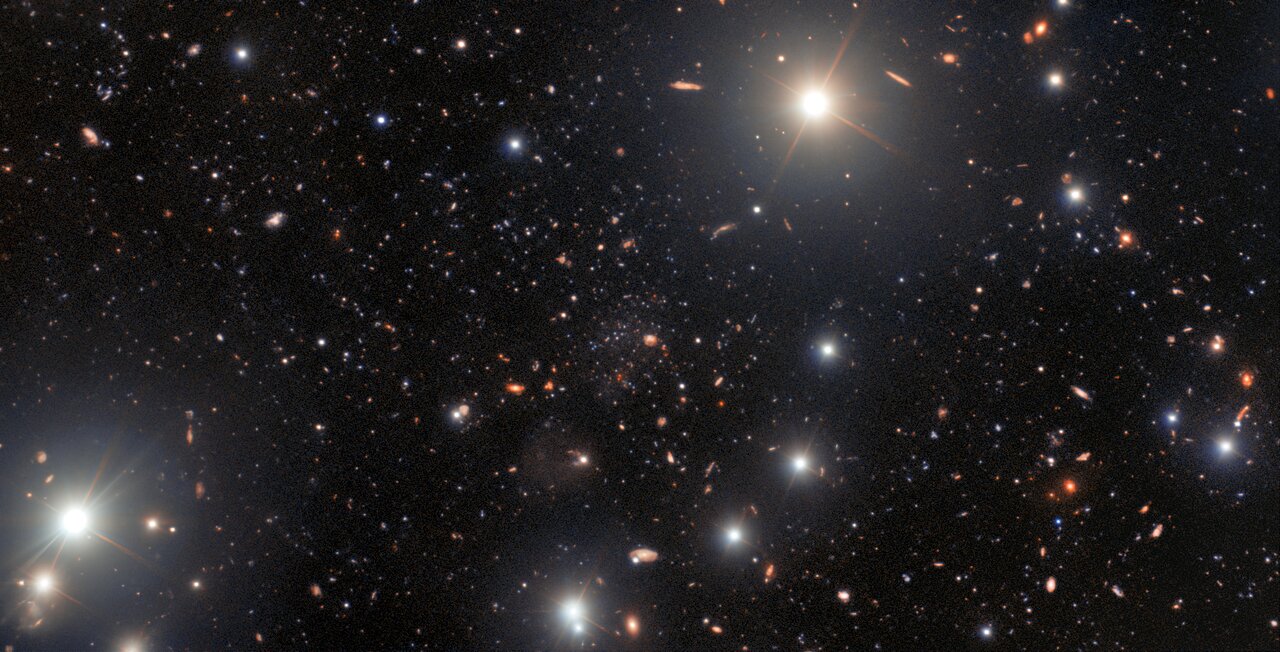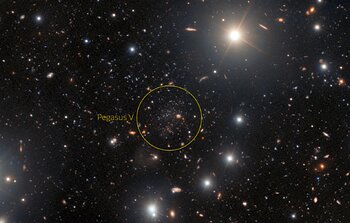Gemini North Spies Ultra-Faint Fossil Galaxy Discovered on Outskirts of Andromeda
June 30, 2022
NSF NOIRLab facilities reveal a relict of the earliest galaxies

An unusual ultra-faint dwarf galaxy has been discovered on the outer fringes of the Andromeda Galaxy thanks to the sharp eyes of an amateur astronomer examining archival data processed by NSF NOIRLab’s Community Science and Data Center. Follow-up by professional astronomers using the International Gemini Observatory, a Program of NSF NOIRLab, revealed that the dwarf galaxy — Pegasus V — contains very few heavier elements and is likely to be a fossil of the first galaxies.
An unusual ultra-faint dwarf galaxy has been discovered on the edge of the Andromeda Galaxy using several facilities of NSF's NOIRLab. The galaxy, called Pegasus V, was first detected as part of a systematic search for Andromeda dwarfs coordinated by David Martinez-Delgado from the Instituto de Astrofísica de Andalucía, Spain, when amateur astronomer Giuseppe Donatiello found an interesting ‘smudge’ in data in a DESI Legacy Imaging Surveys image [1]. The image was taken with the US Department of Energy-fabricated Dark Energy Camera on the Víctor M. Blanco 4-meter Telescope at Cerro Tololo Inter-American Observatory (CTIO). The data were processed through the Community Pipeline which is operated by NOIRLab's Community Science and Data Center (CSDC).
Follow-up deeper observations by astronomers using the larger, 8.1-meter Gemini North telescope with the GMOS instrument, revealed faint stars in Pegasus V, confirming that it is an ultra-faint dwarf galaxy on the outskirts of the Andromeda Galaxy. Gemini North in Hawai‘i is one half of the International Gemini Observatory.
The observations with Gemini revealed that the galaxy appears to be extremely deficient in heavier elements compared to similar dwarf galaxies, meaning that it is very old and likely to be a fossil of the first galaxies in the Universe.
“We have found an extremely faint galaxy whose stars formed very early in the history of the Universe," commented Michelle Collins, an astronomer at the University of Surrey, UK and lead author of the paper announcing this discovery. “This discovery marks the first time a galaxy this faint has been found around the Andromeda Galaxy using an astronomical survey that wasn't specifically designed for the task.”
The faintest galaxies are considered to be fossils of the very first galaxies that formed, and these galactic relics contain clues about the formation of the earliest stars. While astronomers expect the Universe to be teeming with faint galaxies like Pegasus V [2], they have not yet discovered nearly as many as their theories predict. If there are truly fewer faint galaxies than predicted this would imply a serious problem with astronomers' understanding of cosmology and dark matter.
Discovering examples of these faint galaxies is therefore an important endeavor, but also a difficult one. Part of the challenge is that these faint galaxies are extremely tricky to spot, appearing as just a few sparse stars hidden in vast images of the sky.
“The trouble with these extremely faint galaxies is that they have very few of the bright stars which we typically use to identify them and measure their distances,” explained Emily Charles, a PhD student at the University of Surrey who was also involved in the study. “Gemini’s 8.1-meter mirror allowed us to find faint, old stars which enabled us both to measure the distance to Pegasus V and to determine that its stellar population is extremely old.”
The strong concentration of old stars that the team found in Pegasus V suggests that the object is likely a fossil of the first galaxies. When compared with the other faint galaxies around Andromeda, Pegasus V seems uniquely old and metal-poor, indicating that its star formation ceased very early indeed.
“We hope that further study of Pegasus V’s chemical properties will provide clues into the earliest periods of star formation in the Universe,” concluded Collins. “This little fossil galaxy from the early Universe may help us understand how galaxies form, and whether our understanding of dark matter is correct.”
“The public-access Gemini North telescope provides an array of capabilities for community astronomers,” said Martin Still, Gemini Program Officer at the National Science Foundation. “In this case, Gemini supported this international team to confirm the presence of the dwarf galaxy, associate it physically with the Andromeda Galaxy, and determine the metal-deficient nature of its evolved stellar population."
Upcoming astronomical facilities are set to shed more light on faint galaxies. Pegasus V was witness to a time in the history of the Universe known as reionization, and other objects dating back to this time will soon be observed with NASA’s James Webb Space Telescope. Astronomers also hope to discover other such faint galaxies in the future using Vera C. Rubin Observatory, a Program of NSF's NOIRLab. Rubin Observatory will conduct an unprecedented, decade-long survey of the optical sky called the Legacy Survey of Space and Time (LSST).
More Information
This research was presented in a paper entitled “Pegasus V — a newly discovered ultra-faint dwarf galaxy on the outskirts of Andromeda” to appear in Monthly Notices of the Royal Astronomical Society.
The team is composed of Michelle L. M. Collins (Physics Department, University of Surrey, UK), Emily J. E. Charles (Physics Department, University of Surrey, UK), David Martínez-Delgado (Instituto de Astrofísica de Andalucía, Spain), Matteo Monelli (Instituto de Astrofísica de Canarias (IAC) and Universidad de La Laguna, Spain), Noushin Karim (Physics Department, University of Surrey, UK), Giuseppe Donatiello (UAI – Unione Astrofili Italiani, Italy), Erik J. Tollerud (Space Telescope Science Institute, USA), Walter Boschin (Instituto de Astrofísica de Canarias (IAC), Universidad de La Laguna, and Fundación G. Galilei - INAF (Telescopio Nazionale Galileo), Spain).
NSF NOIRLab(National Optical-Infrared Astronomy Research Laboratory), the US center for ground-based optical-infrared astronomy, operates the International Gemini Observatory(a facility of NSF, NRC–Canada, ANID–Chile, MCTIC–Brazil, MINCyT–Argentina, and KASI–Republic of Korea), Kitt Peak National Observatory (KPNO), Cerro Tololo Inter-American Observatory (CTIO), the Community Science and Data Center (CSDC), and Vera C. Rubin Observatory(operated in cooperation with the Department of Energy’s SLACNational Accelerator Laboratory). It is managed by the Association of Universities for Research in Astronomy (AURA) under a cooperative agreement with NSF and is headquartered in Tucson, Arizona. The astronomical community is honored to have the opportunity to conduct astronomical research on Iolkam Du’ag (Kitt Peak) in Arizona, on Maunakea in Hawai‘i, and on Cerro Tololo and Cerro Pachón in Chile. We recognize and acknowledge the very significant cultural role and reverence that these sites have to the Tohono O'odham Nation, to the Native Hawaiian community, and to the local communities in Chile, respectively.
Links
Contacts
Michelle Collins
m.collins@surrey.ac.uk
University of Surrey
Amanda Kocz
amanda.kocz@noirlab.edu
+1 520 318 8591
Communications Manager
NSF NOIRLab



